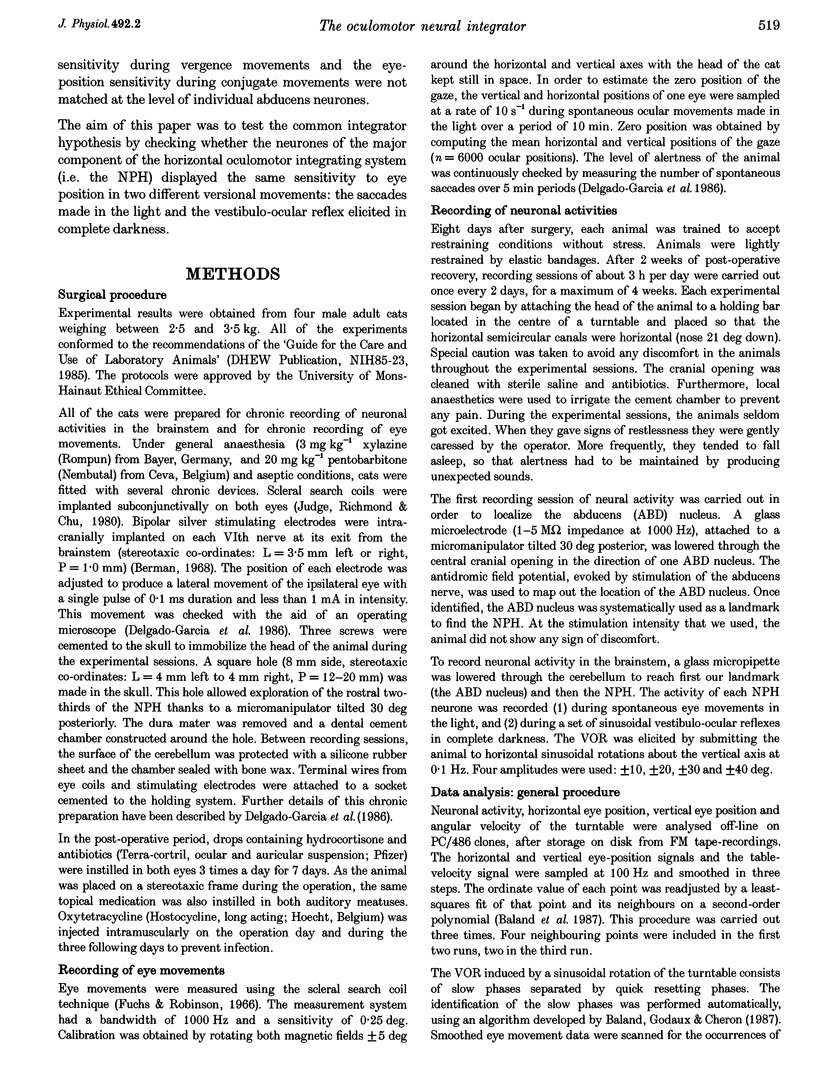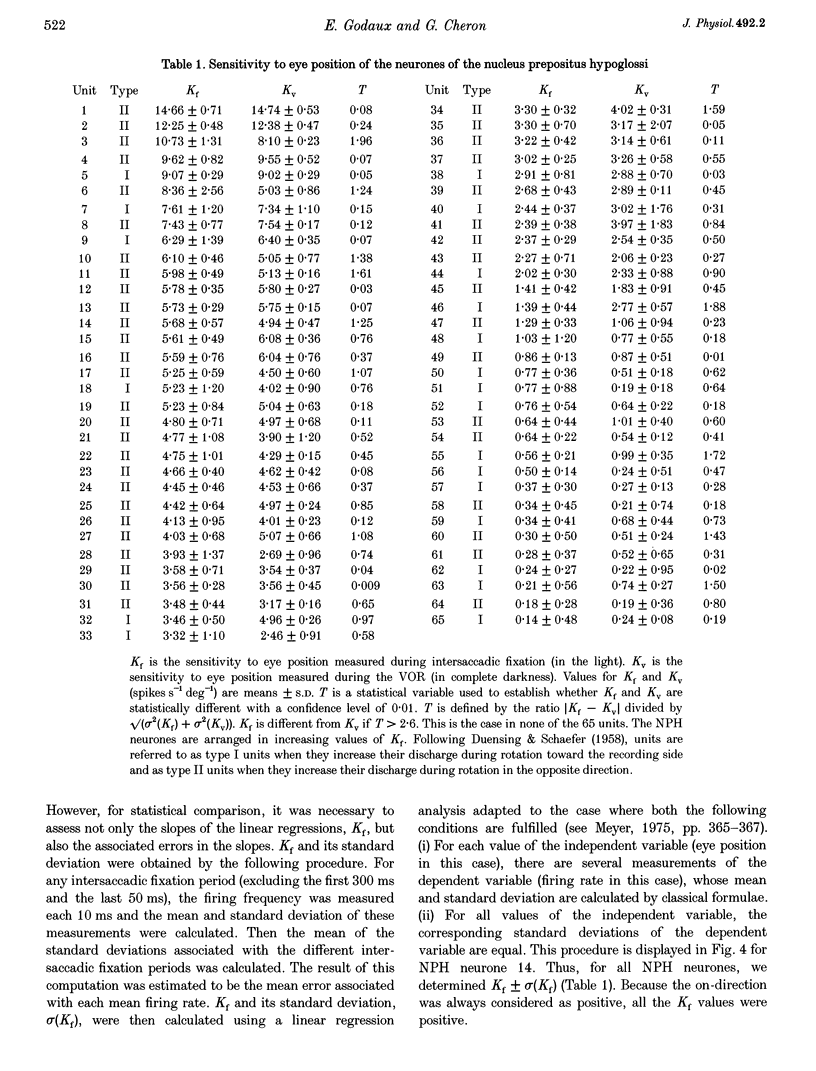Abstract
1. As far as horizontal eye movements are concerned, the well-known hypothesis, not yet experimentally proved, of the common neural integrator states that the eye-position signal is generated by a common network, regardless of the type of versional movement. The aim of this study was to evaluate the validity of this hypothesis by checking whether the sensitivity to eye position of the neurones of the nucleus prepositus hypoglossi (NPH) (the main component of the system integrating the different incoming velocity signals) would be the same regardless of the type of versional movement. 2. The discharge of sixty-five NPH neurones was recorded in the alert cat during spontaneous eye movements made in the light and in response to sinusoidal rotations of the head in complete darkness. 3. For each NPH neurone, the sensitivity to eye position was determined from measurements carried out during intersaccadic fixation. The discharge rate of the studied neurone was plotted against eye position. The slope of the resulting regression line gave the sensitivity (measured during intersaccadic fixation in the light) of the neurone to eye position, which was termed K(f). 4. A new method was developed to measure the sensitivity to eye position (K(v)) of neurones during vestibular slow phases. The difficulty came from the fact that, during slow phases, eye velocity and eye position changed simultaneously and that each of those two variables could influence neuronal activity. For each neurone, the instantaneous firing rate was measured each time the eye passed through a given position during any slow phase generated during any vestibulo-ocular reflex. At a given position, the discharge rate of the neurone under study was plotted against the eye velocity. From the resulting linear regression line, two interesting values were obtained: its slope, corresponding to the sensitivity of the neurone to eye velocity, R(v), (at that given eye position) and its 'y'-intercept, F(0), the interpolated firing rate when the eye velocity was zero. This procedure was repeated for different eye positions. The values of F(0) were then plotted against the eye positions. The slope of the resulting regression line gave the sensitivity (measured during vestibular stimulation) of the neurone to eye position, which was termed K(v). 5. The errors on the individual values of K(f) and K(v) were assessed in order to allow a statistical comparison at the single unit level. 6. We found that, for each of our sixty-five neurones, the sensitivity to eye position measured during intersaccadic fixation in the light was equal to the sensitivity to eye position measured during the vestibulo-ocular reflex (VOR) elicited in complete darkness. We conclude that our results favour the hypothesis of a unique horizontal oculomotor integrator for all versional movements.
Full text
PDF










Images in this article
Selected References
These references are in PubMed. This may not be the complete list of references from this article.
- Baker R., Evinger C., McCrea R. A. Some thoughts about the three neurons in the vestibular ocular reflex. Ann N Y Acad Sci. 1981;374:171–188. doi: 10.1111/j.1749-6632.1981.tb30869.x. [DOI] [PubMed] [Google Scholar]
- Baland J. F., Godaux E. R., Cheron G. A. Algorithms for the analysis of the nystagmic eye movements induced by sinusoidal head rotations. IEEE Trans Biomed Eng. 1987 Oct;34(10):811–816. doi: 10.1109/tbme.1987.325923. [DOI] [PubMed] [Google Scholar]
- Blanks R. H., Estes M. S., Markham C. H. Physiologic characteristics of vestibular first-order canal neurons in the cat. II. Response to constant angular acceleration. J Neurophysiol. 1975 Sep;38(5):1250–1268. doi: 10.1152/jn.1975.38.5.1250. [DOI] [PubMed] [Google Scholar]
- Cannon S. C., Robinson D. A. Loss of the neural integrator of the oculomotor system from brain stem lesions in monkey. J Neurophysiol. 1987 May;57(5):1383–1409. doi: 10.1152/jn.1987.57.5.1383. [DOI] [PubMed] [Google Scholar]
- Cheron G., Gillis P., Godaux E. Lesions in the cat prepositus complex: effects on the optokinetic system. J Physiol. 1986 Mar;372:95–111. doi: 10.1113/jphysiol.1986.sp015999. [DOI] [PMC free article] [PubMed] [Google Scholar]
- Cheron G., Godaux E. Disabling of the oculomotor neural integrator by kainic acid injections in the prepositus-vestibular complex of the cat. J Physiol. 1987 Dec;394:267–290. doi: 10.1113/jphysiol.1987.sp016870. [DOI] [PMC free article] [PubMed] [Google Scholar]
- Cheron G., Godaux E., Laune J. M., Vanderkelen B. Lesions in the cat prepositus complex: effects on the vestibulo-ocular reflex and saccades. J Physiol. 1986 Mar;372:75–94. doi: 10.1113/jphysiol.1986.sp015998. [DOI] [PMC free article] [PubMed] [Google Scholar]
- Cheron G., Mettens P., Godaux E. Gaze holding defect induced by injections of ketamine in the cat brainstem. Neuroreport. 1992 Jan;3(1):97–100. doi: 10.1097/00001756-199201000-00026. [DOI] [PubMed] [Google Scholar]
- Collewijn H. Direction-selective units in the rabbit's nucleus of the optic tract. Brain Res. 1975 Dec 26;100(3):489–508. doi: 10.1016/0006-8993(75)90154-7. [DOI] [PubMed] [Google Scholar]
- Crawford J. D., Cadera W., Vilis T. Generation of torsional and vertical eye position signals by the interstitial nucleus of Cajal. Science. 1991 Jun 14;252(5012):1551–1553. doi: 10.1126/science.2047862. [DOI] [PubMed] [Google Scholar]
- DUENSING F., SCHAEFER K. P. Die Aktivität einzelner Neurone im Bereich der Vestibulariskerne bei Horizontalbeschleunigungen unter besonderer Berücksichtigung des vestibulären Nystagmus. Arch Psychiatr Nervenkr Z Gesamte Neurol Psychiatr. 1958;198(2):225–252. doi: 10.1007/BF00941383. [DOI] [PubMed] [Google Scholar]
- Delgado-Garcia J. M., del Pozo F., Baker R. Behavior of neurons in the abducens nucleus of the alert cat--I. Motoneurons. Neuroscience. 1986 Apr;17(4):929–952. doi: 10.1016/0306-4522(86)90072-2. [DOI] [PubMed] [Google Scholar]
- Escudero M., de la Cruz R. R., Delgado-García J. M. A physiological study of vestibular and prepositus hypoglossi neurones projecting to the abducens nucleus in the alert cat. J Physiol. 1992 Dec;458:539–560. doi: 10.1113/jphysiol.1992.sp019433. [DOI] [PMC free article] [PubMed] [Google Scholar]
- Evinger C., Fuchs A. F. Saccadic, smooth pursuit, and optokinetic eye movements of the trained cat. J Physiol. 1978 Dec;285:209–229. doi: 10.1113/jphysiol.1978.sp012568. [DOI] [PMC free article] [PubMed] [Google Scholar]
- Fernandez C., Goldberg J. M. Physiology of peripheral neurons innervating semicircular canals of the squirrel monkey. II. Response to sinusoidal stimulation and dynamics of peripheral vestibular system. J Neurophysiol. 1971 Jul;34(4):661–675. doi: 10.1152/jn.1971.34.4.661. [DOI] [PubMed] [Google Scholar]
- Fuchs A. F., Kaneko C. R., Scudder C. A. Brainstem control of saccadic eye movements. Annu Rev Neurosci. 1985;8:307–337. doi: 10.1146/annurev.ne.08.030185.001515. [DOI] [PubMed] [Google Scholar]
- Fuchs A. F., Luschei E. S. Firing patterns of abducens neurons of alert monkeys in relationship to horizontal eye movement. J Neurophysiol. 1970 May;33(3):382–392. doi: 10.1152/jn.1970.33.3.382. [DOI] [PubMed] [Google Scholar]
- Fuchs A. F., Robinson D. A. A method for measuring horizontal and vertical eye movement chronically in the monkey. J Appl Physiol. 1966 May;21(3):1068–1070. doi: 10.1152/jappl.1966.21.3.1068. [DOI] [PubMed] [Google Scholar]
- Fukushima K. The interstitial nucleus of Cajal and its role in the control of movements of head and eyes. Prog Neurobiol. 1987;29(2):107–192. doi: 10.1016/0301-0082(87)90016-5. [DOI] [PubMed] [Google Scholar]
- Godaux E., Cheron G. Testing the common neural integrator hypothesis at the level of the individual abducens motoneurones in the alert cat. J Physiol. 1993 Sep;469:549–570. doi: 10.1113/jphysiol.1993.sp019829. [DOI] [PMC free article] [PubMed] [Google Scholar]
- Godaux E., Vanderkelen B. Vestibulo-ocular reflex, optokinetic response and their interactions in the cerebellectomized cat. J Physiol. 1984 Jan;346:155–170. doi: 10.1113/jphysiol.1984.sp015013. [DOI] [PMC free article] [PubMed] [Google Scholar]
- Henn V., Cohen B. Coding of information about rapid eye movements in the pontine reticular formation of alert monkeys. Brain Res. 1976 May 28;108(2):307–325. doi: 10.1016/0006-8993(76)90188-8. [DOI] [PubMed] [Google Scholar]
- Henn V., Cohen B. Quantitative analysis of activity in eye muscle motoneurons during saccadic eye movements and positions of fixation. J Neurophysiol. 1973 Jan;36(1):115–126. doi: 10.1152/jn.1973.36.1.115. [DOI] [PubMed] [Google Scholar]
- Hoffmann K. P., Schoppmann A. Retinal input to direction selective cells in the nucleus tractus opticus of the cat. Brain Res. 1975 Dec 5;99(2):359–366. doi: 10.1016/0006-8993(75)90037-2. [DOI] [PubMed] [Google Scholar]
- Jones G. M., Milsum J. H. Characteristics of neural transmission from the semicircular canal to the vestibular nuclei of cats. J Physiol. 1970 Aug;209(2):295–316. doi: 10.1113/jphysiol.1970.sp009166. [DOI] [PMC free article] [PubMed] [Google Scholar]
- Judge S. J., Richmond B. J., Chu F. C. Implantation of magnetic search coils for measurement of eye position: an improved method. Vision Res. 1980;20(6):535–538. doi: 10.1016/0042-6989(80)90128-5. [DOI] [PubMed] [Google Scholar]
- Kaneko C. R., Evinger C., Fuchs A. F. Role of cat pontine burst neurons in generation of saccadic eye movements. J Neurophysiol. 1981 Sep;46(3):387–408. doi: 10.1152/jn.1981.46.3.387. [DOI] [PubMed] [Google Scholar]
- Keller E. L. Participation of medial pontine reticular formation in eye movement generation in monkey. J Neurophysiol. 1974 Mar;37(2):316–332. doi: 10.1152/jn.1974.37.2.316. [DOI] [PubMed] [Google Scholar]
- Komatsu H., Wurtz R. H. Relation of cortical areas MT and MST to pursuit eye movements. I. Localization and visual properties of neurons. J Neurophysiol. 1988 Aug;60(2):580–603. doi: 10.1152/jn.1988.60.2.580. [DOI] [PubMed] [Google Scholar]
- Lisberger S. G., Westbrook L. E. Properties of visual inputs that initiate horizontal smooth pursuit eye movements in monkeys. J Neurosci. 1985 Jun;5(6):1662–1673. doi: 10.1523/JNEUROSCI.05-06-01662.1985. [DOI] [PMC free article] [PubMed] [Google Scholar]
- Mays L. E., Porter J. D. Neural control of vergence eye movements: activity of abducens and oculomotor neurons. J Neurophysiol. 1984 Oct;52(4):743–761. doi: 10.1152/jn.1984.52.4.743. [DOI] [PubMed] [Google Scholar]
- McFarland J. L., Fuchs A. F. Discharge patterns in nucleus prepositus hypoglossi and adjacent medial vestibular nucleus during horizontal eye movement in behaving macaques. J Neurophysiol. 1992 Jul;68(1):319–332. doi: 10.1152/jn.1992.68.1.319. [DOI] [PubMed] [Google Scholar]
- Mettens P., Godaux E., Cheron G., Galiana H. L. Effect of muscimol microinjections into the prepositus hypoglossi and the medial vestibular nuclei on cat eye movements. J Neurophysiol. 1994 Aug;72(2):785–802. doi: 10.1152/jn.1994.72.2.785. [DOI] [PubMed] [Google Scholar]
- Robinson D. A. Eye movement control in primates. The oculomotor system contains specialized subsystems for acquiring and tracking visual targets. Science. 1968 Sep 20;161(3847):1219–1224. doi: 10.1126/science.161.3847.1219. [DOI] [PubMed] [Google Scholar]
- Skavenski A. A., Robinson D. A. Role of abducens neurons in vestibuloocular reflex. J Neurophysiol. 1973 Jul;36(4):724–738. doi: 10.1152/jn.1973.36.4.724. [DOI] [PubMed] [Google Scholar]
- Van Gisbergen J. A., Robinson D. A., Gielen S. A quantitative analysis of generation of saccadic eye movements by burst neurons. J Neurophysiol. 1981 Mar;45(3):417–442. doi: 10.1152/jn.1981.45.3.417. [DOI] [PubMed] [Google Scholar]



